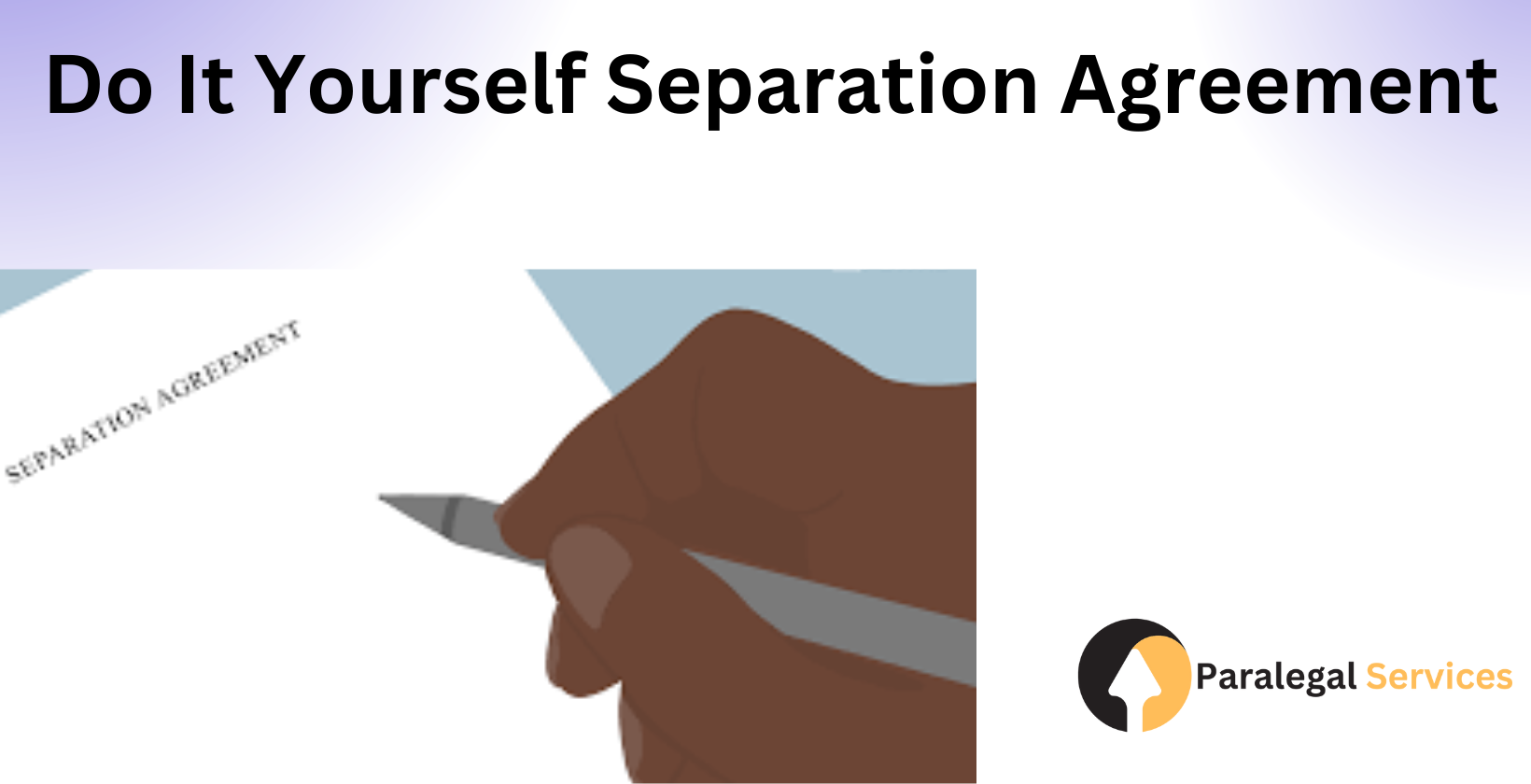A DIY separation agreement empowers individuals to outline the terms of their separation without hiring a lawyer, offering a practical solution for those seeking affordability, privacy, and efficiency. This approach appeals to people who want to save on legal fees, which can range from $1,500 to $10,000 according to a 2023 Nolo survey, while maintaining control over personal matters and resolving issues quickly—often in weeks rather than months. By choosing this route, couples can avoid public courtroom disputes and tailor agreements to their unique needs.
A separation agreement is a written document that legally defines how separating parties—typically married couples, common-law partners, or domestic partners—handle assets, debts, custody, and support. It applies to those ending relationships but not necessarily divorcing, recognized under state laws in the U.S., such as California’s Family Code Section 231 or New York’s Domestic Relations Law Section 170. This article explores where to find reliable DIY templates, their practical uses, and key considerations, equipping self-representing individuals with clear, actionable guidance.
Where can I find a printable Do It Yourself Separation Agreement?
Printable DIY separation agreements are available through legal aid websites like LegalZoom, government portals such as state court websites (e.g., TexasLawHelp.org), and reputable platforms like Best Paralegal Services. These resources provide free and paid options, with free templates often found on nonprofit sites and paid versions, averaging $30-$50, offering customization. Jurisdiction matters—forms must comply with local laws, like Florida’s requirement for notarization under Statute 61.052 or Illinois’ asset disclosure rules. Always verify the source’s credibility to ensure legal validity.
Evaluate templates based on accuracy, how often they’re updated (e.g., annual revisions for law changes), and whether lawyers review them. Free forms from government sites are reliable but basic, while paid options from platforms like LawDepot include step-by-step guides and support. A 2022 study by the American Bar Association found 68% of DIY users preferred lawyer-reviewed templates for peace of mind. Check reviews, sample documents, and compliance with your state’s statutes before downloading.
What is a Separation Agreement Form used for?
A separation agreement form outlines terms like splitting bank accounts, dividing homes, setting child custody schedules, and arranging spousal support. It clarifies who pays debts, who lives where, and how expenses like health insurance or school fees are handled. For example, couples might agree to sell a $300,000 property and split proceeds 50-50 or assign custody 60% to one parent based on work schedules. These documents reduce conflict by setting clear expectations.
Legally, it’s binding once signed and notarized in most states, per cases like Ohio’s Sowald v. Sowald (1998), and courts use it to enforce terms or guide divorce proceedings. It impacts taxes—spousal support is deductible for the payer under IRS Publication 504—benefits eligibility, and insurance adjustments. Married couples use it to formalize separation, common-law partners in states like Texas to divide property (Texas Family Code Section 2.401), and domestic partners to end registered unions, ensuring all parties’ rights are addressed.
How Can I Get Separation Papers Online?
Getting separation papers online is pretty straightforward if you stick to trusted sources. Start with state court websites like New York’s nycourts.gov or California’s courts.ca.gov, which offer free, state-specific forms that match local legal standards. Legal aid sites like TexasLawHelp.org or the Legal Services Corporation (lsc.gov) also provide dependable templates at no cost, while platforms like Best Paralegal Services charge affordable rates for customizable options tailored to your state. Steer clear of random “free” downloads from sketchy sites—those might be outdated or scams, and courts could reject them.
After downloading, check if your state requires extras like notarization (think Florida’s Statute 61.052) or filing with a court. Using forms designed for your state avoids headaches from generic templates that miss the mark on local rules, making the process smoother and legally sound.
Can I Draw Up My Own Separation Agreement?
Yes, you can absolutely draft your own separation agreement, and it’ll hold up legally if both parties agree, it’s clear, and it follows your state’s laws. This works best when you and your ex see eye-to-eye on things like splitting assets or custody, keeping it simple and drama-free. Courts in places like Pennsylvania will enforce it if it’s fair and transparent about assets, but starting with a template from a state court site or Rocket Lawyer can help you avoid mistakes that might tank it later.
If kids or big money are involved, consider having a lawyer peek at it—studies show agreements with a legal once-over are way more likely to stick in court. Without mutual consent or if it’s sloppy, you risk it being tossed out, so clarity and agreement are non-negotiable.
How Do I Write a Simple Separation Agreement?
Writing a simple separation agreement means covering the basics: your names, the date you’re separating, how you’ll split assets and debts, any spousal support details, and custody plans if kids are involved. Keep it straightforward—say things like “Jane takes the savings account; John keeps the truck”—and make sure it tackles all the big stuff so nothing’s left hanging. Both of you need to sign it willingly, and in states like Florida, you’ll need a notary to make it official under Statute 61.052.
Use plain language to avoid confusion, and don’t skip details that could trip you up later—courts hate vague agreements. If you want it to hold water, maybe get a lawyer to check it, especially if the stakes are high, but as long as it’s clear and mutual, you’re on solid ground.
What is the first thing to do when separating?
The first step when separating is to gather all relevant financial records, such as bank statements, property deeds, and debt documents, to get a clear picture of shared assets and liabilities. Next, set up separate bank accounts and credit cards to establish financial independence and avoid disputes over spending. It’s also important to document the official date of separation, as this can affect legal matters like property division and spousal support. For example, in some states like California, the separation date determines when earnings and debts stop being communal.
If children or shared assets are involved, open communication or mediation can help reduce conflicts. Studies show that couples who use mediation report fewer disputes after separating. Consulting a lawyer or reviewing your rights early on can also protect both parties, ensuring informed decisions and minimizing the risk of future legal issues.
Can I file for legal separation myself?
Yes, in most places, you can file for legal separation without a lawyer, often through self-help centers or court websites that provide forms and instructions. For example, in Texas, you can download a Petition for Legal Separation from the state court website, fill it out, and file it with the county clerk for a fee of about $300. The process usually involves submitting the petition, serving it to your spouse, and attending a court hearing if needed. This works well in uncontested cases where both parties agree on terms like asset division and custody.
However, if your case involves complex custody issues or significant assets, getting legal help is a smart move. Research shows that people handling complex cases on their own are more likely to face unfavorable outcomes. If you’re unsure, many courts offer free legal clinics or online resources to guide you.
Where can I download a Separation Agreement Template?
You can download separation agreement templates from trusted sources like state court websites, such as California Courts (courts.ca.gov) or New York’s Unified Court System (nycourts.gov), which offer free, state-specific forms. Nonprofit legal aid organizations like Legal Services Corporation (lsc.gov) also provide reliable options, while commercial sites like Best Paralegal Services offer customizable templates. Make sure the template fits your state’s laws and your situation—forms vary depending on whether children or complex assets are involved.
Before signing, review the template carefully to ensure it covers all necessary terms. Consider having a lawyer check it over to avoid enforceability problems—surveys show that many DIY agreements without legal review face challenges in court. A quick consultation can help ensure everything holds up legally.
Where can I get a Free Separation Agreement?
Free separation agreement templates can be found on official government and legal aid websites, providing dependable resources for those seeking to formalize a separation. For instance, the California Courts Self-Help Center, accessible at courts.ca.gov, offers downloadable forms under its Self-Help section, specifically Family Law and Legal Separation, tailored to California residents. Similarly, the New York State Unified Court System at nycourts.gov provides a sample separation agreement within its Forms area under Family Court Forms, focusing on Separation and Divorce. TexasLawHelp.org, a valuable resource for Texans, includes a Marital Settlement Agreement suitable for separations, located in the Family, Divorce & Children section under Forms. Additionally, nonprofit services like LawHelp.org connect users to state-specific legal forms, such as those from LawHelp California and TexasLawHelp.org, broadening access to free options.
The process to access these templates is simple and user-friendly, requiring no registration or eligibility checks for downloads, which are typically offered as PDFs or editable Word documents. While some legal aid organizations might restrict personalized help based on income, the forms themselves are freely available to all. Local county court websites, like the Superior Court of Los Angeles County at lacourt.org, also provide family law forms, including separation agreements, making it worth checking your own jurisdiction’s site for further resources.
Where can I find a Free Separation Agreement Form?
Jurisdiction-based court websites are a prime source for free separation agreement forms, offering templates designed to meet state-specific legal standards. In California, the California Courts Self-Help Center at courts.ca.gov houses forms like the Petition for Legal Separation (FL-100) and sample settlement agreements, found under Self-Help, then Family Law, and Legal Separation, with versions for couples with or without children. The New York Courts website at nycourts.gov features a sample separation agreement in its Forms section under Family Court Forms and Separation and Divorce, addressing property and child-related provisions. For Texas, TexasLawHelp.org provides a Marital Settlement Agreement in its Family, Divorce & Children section under Forms, adaptable to various separation needs.
These forms are generally provided as fillable PDFs or editable Word documents, ensuring ease of use. Instructions accompany them: California requires forms to be signed, notarized, and paired with a Judgment form for court submission, while New York mandates signatures and notarization, with filing details outlined on the site. Following these guidelines is key to ensuring the agreement holds legal weight, so reviewing the source’s instructions is essential.
Is there a Free Printable Separation Agreement available online?
Free printable separation agreements in PDF format are readily available online through reputable legal websites and public domain repositories. The New York Courts website at nycourts.gov includes a printable sample separation agreement within its divorce packet, while TexasLawHelp.org offers a printable Marital Settlement Agreement. California Courts at courts.ca.gov also provides sample agreements that can be printed and used as templates. These documents may follow state-specific guidelines or serve as general templates, depending on the source, offering flexibility for users.
Designed for DIY use, these printable PDFs are clearly labeled as such—not view-only—and include critical clauses like asset division, custody arrangements, and support terms. However, they might not cover complex situations, so consulting a lawyer is wise for significant assets or disputes. Source websites often note that these forms are informational, not legal advice, and provide instructions like signing, notarizing, and filing, ensuring users understand their responsibilities.
What is a Marriage Separation Agreement?
A Marriage Separation Agreement is a temporary legal document that outlines the rights and responsibilities of spouses during their separation, providing a structured way to manage their affairs while living apart. According to authoritative legal sources like Nolo and FindLaw, its primary purpose is to address critical issues such as property division, spousal support, child custody, and debt allocation without requiring an immediate divorce. This agreement allows couples to establish clear terms during a trial separation or as a step toward divorce, and it’s widely recognized across the U.S., though its name may vary by jurisdiction—for instance, it’s called a “separation agreement” in New York and may be part of a “marital settlement agreement” in California if divorce follows.
The common components of this agreement include the division of assets like homes, vehicles, and bank accounts; arrangements for spousal support or alimony; child custody and visitation schedules; and the allocation of debts such as loans or credit card balances. LegalMatch emphasizes that for enforceability, these agreements must be fair, entered into voluntarily, and include full financial disclosure. Governed by state family law statutes—like California’s Family Code Section 2310 or New York’s Domestic Relations Law Section 170—these documents often serve as a foundation for divorce settlements if the couple later dissolves their marriage, ensuring legal clarity and protection for both parties.
How do I obtain official Separation Papers?
Obtaining official Separation Papers depends on the jurisdiction, as some states require filing with a court while others allow private drafting. In California, for example, legal separation requires court involvement: you must complete forms like the Petition for Legal Separation (FL-100), serve them to your spouse, and file with the county clerk for a fee of about $435. Both parties can file jointly if they agree on terms, or one spouse can initiate the process alone, with detailed guidance available on the California Courts website (courts.ca.gov). In New York, however, couples can draft a separation agreement privately, have it notarized, and live apart without court filing—though to make it a formal legal separation, they must file it with the court alongside a summons and complaint, paying a $210 fee, as outlined on the New York State Unified Court System’s website (nycourts.gov).
The process varies in complexity depending on mutual agreement and state rules. In California, additional forms may be needed if children or significant property are involved, while New York requires the agreement to comply with Domestic Relations Law Section 170 for enforceability. Checking official court websites for specific instructions and forms ensures the papers are correctly obtained and legally binding, whether filed jointly or by one party against the other.
Where can I get Legal Separation Papers?
Legal Separation Papers are typically available through state court websites and government portals, which offer jurisdiction-specific downloadable forms. For instance, California’s Judicial Branch provides the FL-100 Petition for Legal Separation and related documents on its Self-Help Center (courts.ca.gov), while New York’s Unified Court System offers separation forms under its Family Law section (nycourts.gov). Other states, like Texas, provide templates via resources such as TexasLawHelp.org (texaslawhelp.org), making it easy to access the right paperwork based on your location.
The required forms can differ depending on factors like children or property, and most states mandate notarization for legal recognition—California also requires court filing. These documents are often available as fillable PDFs or downloadable templates for online completion, though paper versions can be requested in person at courthouses, as in New York. Always consult your state’s official court website to confirm requirements and ensure you’re using the correct, up-to-date forms for your situation.
Meet the Author
Annette E. – Distinguished Paralegal at BestParalegalServices
Annette E. is a distinguished paralegal at BestParalegalServices with comprehensive expertise in supporting solo practitioners and small law firms across diverse legal areas, including contract law, family law, and real estate. She specializes in preparing essential legal documents such as contracts, legal briefs, discovery documents, and client correspondence, ensuring each one meets stringent legal requirements and aligns with both state and federal regulations.
Annette brings over five years of paralegal experience, including extensive litigation support as a law clerk. This background gives her a unique insight into the intricacies of legal proceedings, allowing her to provide exceptional service and attention to detail.
With a Bachelor’s degree in Legal Studies and a certification in paralegal studies, Annette is a trusted professional for attorneys seeking reliable and thorough legal support. Her experience and dedication make her a valuable asset for clients and attorneys alike.



